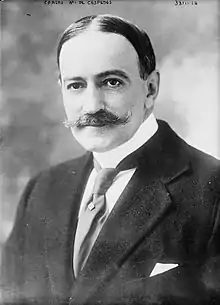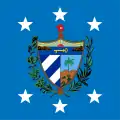Carlos Manuel de Céspedes y Quesada
Carlos Manuel de Céspedes y Quesada (August 12, 1871, New York City, New York, United States – March 28, 1939, Vedado, Havana, Cuba) was a Cuban writer, politician, diplomat, and President of Cuba.
Carlos Manuel de Céspedes y Quesada | |
|---|---|
 Céspedes y Quesada circa 1914 as ambassador to the United States | |
| 6th President of Cuba | |
| In office 12 August 1933 – 5 September 1933 | |
| Vice President | None |
| Preceded by | Gerardo Machado |
| Succeeded by | Ramón Grau |
| Personal details | |
| Born | August 12, 1871 New York City, New York, United States |
| Died | March 28, 1939 (aged 67) Havana, Cuba |
| Nationality | |
| Political party | Liberal Party of Cuba |
| Spouse(s) | Laura Bertini y Alessandri |
| Children | Carlos Manuel and Alba de Céspedes y Bertini |
Early life and career
He was the son of Carlos Manuel de Céspedes and Ana Maria de Quesada y Loinaz. He was also a distant cousin of Perucho Figueredo. In 1915, he married Laura Bertini y Alessandri, an Italian, first in Rome and then later again at City Hall in New York City by Mayor John Purroy Mitchel. They had one child together, the daughter Alba de Céspedes y Bertini. He was educated first in New York City until 1885, when his mother took him and his twin sister to Germany. He later earned degrees in international law and diplomacy from the Instituto Stanislas in Paris, France. In 1895, he returned to Cuba and from 1895 to 1898 he fought in the War of Independence, becoming a teniente coronel (lieutenant colonel) and the revolutionary post of governor of the Province of Santiago de Cuba.

Initial role in Cuban politics
He later entered Cuban politics and from 1902 to 1908, was vice president of the Cuban House of Representatives. Then in 1909, he joined the Cuban diplomatic service and represented his country as minister to Italy, and to Argentina, and as a special envoy to Greece. In 1914, he was Cuban Ambassador to the United States. He returned to Cuba in 1922, to become Foreign Minister under Gerardo Machado but resigned after a year. President Machado then named him Ambassador to Mexico but Céspedes delayed his departure for reasons of ill health.
Presidency
Thereafter, he was active in trying to overthrow Machado. In August 1933, Machado left Cuba and Céspedes was offered the position of President. He took office on August 12, 1933, his 62nd birthday.
Céspedes's Cabinet included Gobernación, Colonel Federico Laredo Bru, Union Nacionalista Justicia, Dr. Carlos Saladrigas Zayas, A.B.C. Hacienda, Dr. Joaquin Martinez Saenz, A.B.C. Obras Públicas, Dr. Eduardo J. Chibas, Liberal Agricultura, Dr. Rafael Santos Jimenez, Marianista Instrucción Pública, Dr Guillermo Belt, Union Nacionalista Sanidad y Beneficencia, Dr. Antonio Presno, University of Habana Comunicaciones, Dr. Nicasio Silverior, O.C.R.R. Guerra y Marina, Demetrio Castillo Pokorny, non-partisan Presidencia, Dr. Raul de Cardenas y Echarte, Conservative[1]
Already by August 19, 1933, Sumner Welles noted the increasing tension that remained within the Cuban army after Céspedes's assumption of the presidency. The reasons for the tensions within the army included that various officials of Machado's administration were allowed to leave the country, that high-ranking army officials who were part of Machado's administration still held their army positions, and that General Sanguily, the Army Chief of Staff, was still hospitalized. Welles noted the following on August 24, 1933:
"I am rapidly coming to the conclusion that my original hope that the present Government of Cuba (Céspedes' administration) could govern as a constitutional government for the remainder of the term for which General Machado had himself elected must be abandoned. If the solid and unwavering support of the Army could be counted on, and if the groups and parties represented in the present Government were unanimous in their support of the administration, it might be possible for the existing Government to maintain itself, pass the necessary legislation of all kinds required, and hold the general national elections in November 1934 as originally anticipated. As a matter of fact, however, a general process of disintegration is going on. The Army is by no means in a satisfactory condition and the relapse in the health of General Sanguily, Chief of Staff and the one ranking officer in the Cuban Army who can command the support of his subordinates, has delayed the taking of the measures necessary to enforce discipline within the Army which he alone could have undertaken satisfactorily.[2]
Given those circumstances, Welles proposed that "general elections may be held approximately 3 months from now so that Cuba may once more have a constitutional government in the real sense of the word." Céspedes agreed, and on August 25, 1933, issued Presidential Decree 1298, which basically annulled the 1928 constitutional reforms and re-established the 1901 Constitution of Cuba in its entirety, terminated the presidential mandate of Machado, dissolved the Cuban Congress, vacated the seats of the Supreme Court of Cuba, and declared that a general election would be held on February 24, 1934, for a new presidential term to begin on May 20, 1934.[3]
Despite those measures, on September 3, 1933, the Sergeants' Revolt took place while Céspedes was in Matanzas and Santa Clara after a hurricane had ravaged those regions. Upon returning and reaching the presidential palace, Ramón Grau and members of the DEU or Directorio Estudiantil Universitario were awaiting him. "At 1 p.m. the Cespedes Cabinet resigned and President Cespedes left the Palace to go to his own house. Very little disorder took place. Immediately thereafter the Committee of five members (Pentarchy of 1933) of the revolutionary group took possession of the Palace as the executive power of the Cuban Republic."[4]
Later life
He then returned to the Foreign Service and became the Cuban Ambassador to Spain. In 1935, he returned to Cuba and wrote several books including Carlos Manuel de Céspedes, Las Banderas de Yara y de Bayamo, and Manuel de Quesada y Loynáz.
He received numerous honors and awards including the Grand Cross of the Order of Carlos Manuel de Céspedes of Cuba, the Grand Cross of Belgium, the Grand Cross of Italy, the Grand Cross of Peru, the Grand Cross of the Spanish Republic, the Grand Ribbon of the Order of the Liberator of Venezuela, the Order of Merit (Chile), Commander of the National Order of the Legion of Honour of France, and of the Order of St. Lazaro and St. Maurice of Italy.
He died on March 28, 1939, in Vedado, Havana, of a heart attack and is buried at Cementerio de Cristóbal Colón in Havana.
References
- Foreign Relations of the United States: Diplomatic Papers, 1933. The American Republics: Volume V,p. 363 http://images.library.wisc.edu/FRUS/EFacs/1933v05/reference/frus.frus1933v05.i0010.pdf
- Foreign Relations of the United States: Diplomatic Papers, 1933. The American Republics: Volume V,p. 371 http://images.library.wisc.edu/FRUS/EFacs/1933v05/reference/frus.frus1933v05.i0010.pdf
- Foreign Relations of the United States: Diplomatic Papers, 1933. The American Republics: Volume V,p. 375 http://images.library.wisc.edu/FRUS/EFacs/1933v05/reference/frus.frus1933v05.i0010.pdf
- Foreign Relations of the United States: Diplomatic Papers, 1933. The American Republics: Volume V,p. 384 http://images.library.wisc.edu/FRUS/EFacs/1933v05/reference/frus.frus1933v05.i0010.pdf
- The Perucho Figueredo Page bio
- Otero, Juan Joaquin (1954). Libro De Cuba, Una Enciclopedia Ilustrada Que Abarca Las Artes, Las Letras, Las Ciencias, La Economia, La Politica, La Historia, La Docencia, Y ElProgreso General De La Nacion Cubana - Edicion Conmemorative del Cincuentenario de la Republica de Cuba, 1902-1952. (Spanish)
External links
| Wikimedia Commons has media related to Carlos Manuel de Céspedes y Quesada. |
| Political offices | ||
|---|---|---|
| Preceded by Alberto Herrera y Franchi |
President of Cuba 12 August 1933 – 5 September 1933 |
Succeeded by Ramón Grau |
